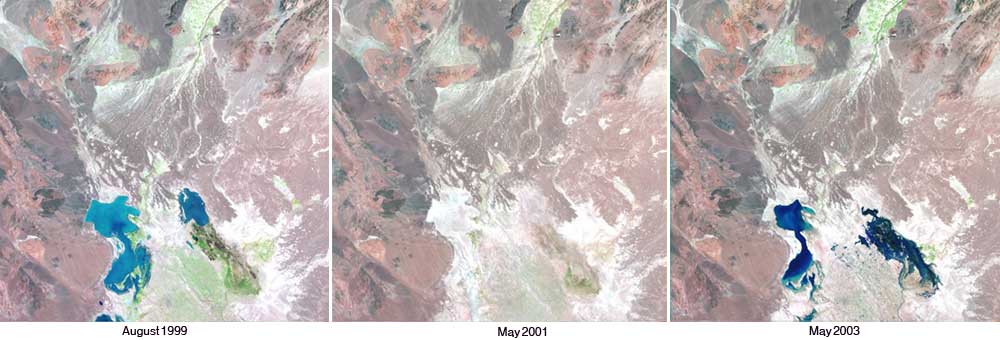 |
| Source: NY Times |
In the 1960's, the Aral Sea was a key component of the regions economy with a fishing industry that employed ~60,000 people. By 1977, the fish harvest had dropped by 75% and by the early 1980's commercial fishing had been eliminated.
The dry lake bed is home to loose soil and precipitated salt crystals. When the wind blows, the exposed sediment is carried into nearby villages and fields, impacting health and salting the soil. Every year, tens of thousands of tons of sediment is picked up and deposited in surrounding areas.
The shrinking Aral Sea has even had a noticeable affect on the region's climate. With the mitigating effect of the water gone, the growing season there is now shorter and hotter, and less precipitation falls.
Well - the Aral Sea is not the only water system that is being over-exploited. This is happening all around the world, from the Middle East to the American West, water supplies, especially freshwater resources, are being destroyed by a combination of diversions, wasteful agricultural practices and the impact of climate change.
On January 30th, the New York Times reported on the current state of Lake Urmia. Once Iran’s largest lake, and one of the largest salt lakes in the world (slightly larger than Great Salt Lake in Utah), the lake is now home to rusting hulks of cruise ships resting on the lake-bed and Iranian environmental officials report that only 5 percent of the water remains. It joins Lake Harmoun (located on the Iran/Afghanistan boarder) in drying out.
Just like with the Aral Sea, the dried salt could poison valuable agricultural lands surrounding the lake, and make life miserable for the three million people who live in its vicinity, causing respiratory problems and other health impacts.
 |
| Time Series of Water in Lake Hamoun, Iran/Afghanistan (Source: NASA) |
Desperate for water, people have resorted to digging wells, to exploit the regions groundwater. “There are around 30,000 legally dug wells and an equal amount of illegal wells,” Mr. Seyed Ghoreishi said. These wells have caused the water table to drop, so that people have to keep digging deeper and deeper.
Unless drastic changes are made soon, Lake Urmia will join the Aral Sea, and an increasing number of other bodies of water, in being a lake in name only - a ghost on old maps but for all practical intents - gone.
www.nytimes.com/2014/01/31/world/middleeast/its-great-lake-shriveled-iran-confronts-crisis-of-water-supply.html
No comments:
Post a Comment
Hi! I do read all of the comments and want to let you know that I really appreciate your stopping by and taking the time to leave a note. Work has fallen in on me and I have not had enough time to reply coherently lately so I apologize preemptively but still want to assure you that your comments are valued. I am using comment moderation to avoid using more annoying spam avoidance. Thanks for your patience.